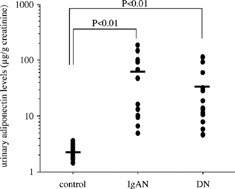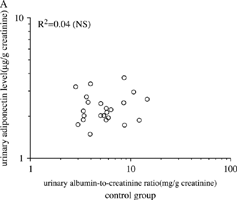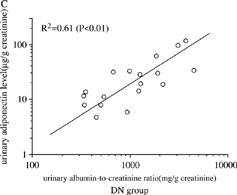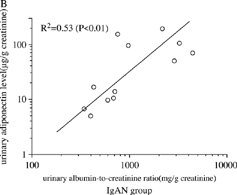Abstract
Adiponectin is secreted specifically by adipose tissue. It was reported that the serum adiponectin level was markedly increased in patients with end-stage renal disease and was positively associated with abnormal renal function in type 2 diabetes. Recently, we found that urinary adiponectin level was significantly increased in type 2 diabetic patients with overt diabetic nephropathy, but not in those without nephropathy. The aim of the present study was to evaluate whether the urinary adiponectin level is increased not only in diabetic patients with macroalbuminuria but also in IgA-nephropathy patients with macroalbuminuria. We measured urinary adiponectin levels in 24 healthy control subjects, 12 IgA-nephropathy patients, and 19 type 2 diabetic nephropathy patients, and they were, in medians, 2.24 µg/g creatinine (ranges of 0.85 ~ 3.70), 59.2 µg/g creatinine (4.95 ~ 186), and 33.1 µg/g creatinine (4.69 ~ 114), respectively. In the two patient groups, urinary adiponectin levels were significantly higher than in control subjects (P < 0.01). Moreover, positive correlations between urinary adiponectin levels and albumin-to-creatinine ratios were observed in IgA-nephropathy (R2 = 0.53, P < 0.01) and diabetic nephropathy patients (R2 = 0.61, P < 0.01), but not in control subjects. Serum adiponectin levels were unchanged in these three groups. These findings suggested that the increase of urinary adiponectin levels partly results from enhanced filtration of circulating adiponectin through the changes of glomerular permselectivity and intraglomerular hydruric pressure. However, clinical implication of urinary adiponectin excretion in healthy control remains to be elucidated.
INTRODUCTION
It is well known that adipose tissue expresses and secretes a variety of hormones and cytokines, including tumor necrosis factor-α, plasminogen activator inhibitor-1, and leptin that are potentially important to development of cardiovascular diseases.Citation[1-4] Adiponectin, the gene product of the adipose tissue most abundant gene transcript 1 (apM1), is secreted specifically by adipose tissue.Citation[5] This protein suppresses the expression of adhesion molecules in vascular endothelial cells and cytokine production from macrophages, thereby inhibiting the inflammatory processes that occur during the early phases of atherosclerosis.Citation[6] Hypoadiponectinemia is reportedly associated with high incidence of coronary artery disease in human.Citation[7&8]
In renal disease, renal insufficiency is a notorious factor promoting cardiovascular complications. Previously, Zoccali et al. reported that levels of serumadiponectin are markedly increased in patients with end-stage renal disease (ESRD) and that patients with higher serum adiponectin levels had a lower risk for a cardiovascular event.Citation[9] They presumed that elevated serum adiponectin levels in nephrotic syndrome might confer a counter-regulatory response aimed at attenuating the vasculotoxic effect of biochemical alternations that attend this syndrome. However, a mechanistic study pertaining to an increase in serum adiponectin levels in patients with proteinuria is needed. Chudek et al. reported that successful kidney transplantation was followed by a significant reduction of serum adiponectin levels.Citation[10] They suggested that the kidney might be involved in adiponectin biodegradation and/or elimination. Taken together with these findings, serum adiponectin level may be affected by renal function. Recently, we demonstrated that urinary adiponectin level was significantly increased in type 2 diabetic patients with overt diabetic nephropathy, but not in those without nephropathy.Citation[11] The serum adiponectin levels were positively correlated with urinary albumin levels in diabetic patients as well. Furthermore, we found that there are also positive correlations between urinary and serum adiponectin levels in patients with micro- and macroalbuminuria. Adiponectin is a small molecule whose molecular weight is 30 kDa.Citation[12] These findings suggest the following mechanistic feasibilities; 1) an increase of urinary adiponectin levels might result from elevations in circulating adiponectin levels and enhanced filtration of this protein through the injured glomerular permselectivity, 2) it might be a consequence independent of serum adiponectin levels, and 3) it might be peculiar to diabetic nephropathy. In the present study, to address these issues, urinary and serum adiponectin levels were measured for a comparison in patients with mildly perturbed nephropathies with distinct causes derived from IgA nephropathy and diabetic nephropathy.
MATERIALS AND METHODS
Study Population
Twelve patients with IgA nephropathy, 19 patients with type 2 diabetes mellitus, and 24 healthy control subjects were recruited for this study. Both IgA nephropathy and type 2 diabetic patients had a macroalbuminuria [urinary albumin excretion (UAE) ≥ 300 mg/g creatinine]. The IgA nephropathy was diagnosed on the basis of renal biopsy and normoglycemia. Overt diabetic nephropathy was diagnosed according to the following criteria: presence of persistent macroalubuminuria, absence of acute or chronic urinary tract infection, and presence of diabetic retinopathy. Subjects with urinary tract infection, other kidney disease, cardiovascular disease, neoplasm, or other concomitants influencing urinary albumin excretion were excluded from this study. Written informed consent was obtained from all study participants.
Measurements
All of the participants were asked to collect timed overnight urine and to bring it to the outpatient block of the hospital in the morning, where blood samples weretaken. All samples were stored at − 80°C until measurement. Serum and urinary adiponectin concentrations were measured by using a commercially available RIA kit (Linco Research, St Louis, MO, USA). Details of accuracy of measuring urinary adiponectin were reported previously.Citation[11] Urinary albumin concentration was measured by using a latex agglutination immunoassay (Eiken Chemical Co., Ltd., Tokyo, Japan). Glycated hemoglobin (HbA1c) was measured by high performance liquid chromatography. Serum and urinary creatinine concentrations were measured by enzymatic methods.
Statistical Analysis
Data are presented as means ± SD or medians with ranges in brackets of data number (n). Differences between group pairs were analyzed by the Mann-Whitney U test after the Kruskal-Wallis test had revealed significant differences among the groups. Due to a skew-deviated distribution, logarithmically transformed values of albumin-to-creatinine ratios and urinary adiponectin were used for the correlation analysis. A P value less than 0.05 was considered statistically significant. All calculations were made by using the Stat View software package (Abacus Concept, Inc, Berkeley, CA, USA).
RESULTS
Clinical characteristics of IgA nephropathy (IgAN), diabetic nephropathy (DN), and control groups are shown in . In the DN group, mean age and body mass index tended to be higher than were those in the other two groups, but they were not statistically significant. Patients' HbA1c and systolic blood pressure were significantly higher in the DN group. Serum creatinine concentration and urinary albumin-to-creatinine ratio (ACR) were significantly higher in both IgAN and DN groups than they were in the control group. There was no significant difference in concentrations of serum adiponectin, total cholesterol, triglyceride, and high density lipoprotein among these three groups.
Table 1. Clinical characteristics of control subjects and patients with IgA nephropathy and type 2 diabetes mellitus.
Individual urinary adiponectin levels of each group were plotted in . Due to a skew-deviated distribution, the data were expressed by logarithm of urinaryadiponectin-to-creatinine ratios. Urinary adiponectin levels of control, IgAN, and DN groups were 2.24 µg/g creatinine (0.85 ~ 3.70), 59.2 µg/g creatinine (4.95 ~ 186), and 33.1 µg/g creatinine (4.69 ~ 114), respectively. In IgAN and DN groups, urinary adiponectin levels were significantly higher than in control group (P < 0.01).
Figure 1. Individual urinary adiponectin levels of control group, IgA-nephropathy group (IgAN) and diabetic nephropathy group (DN). The ordinate data were logarithmically transformed.

shows the correlations between urinary adiponectin levels and ACR. No significant correlation was found in the control group (, R2 = 0.039, NS). On the other hand, a positive correlation was observed in both the IgAN group (, R2 = 0.53, P < 0.01) and the DN group (, R2 = 0.61, P < 0.01). Furthermore, when the data from patients with IgA nephropathy and type 2 diabetes mellitus who had microalbuminuria (UAE 30 ~ 300 mg/g creatinine) were added and reevaluated, positive correlations were observed again in the IgAN group (n = 21, R2 = 0.71, P < 0.01) and the DN group (n = 23, R2 = 0.70, P < 0.01).
DISCUSSION
The objective of the present study was to evaluate whether urinary adiponectin levels are increased not only in diabetic patients with macroalbuminuria but also in patients with other forms of renal disease who have macroalbuminuria. For this purpose, we measured urinary adiponectin levels in patients with IgA nephropathy and compared them with those of patients with diabetic nephropathy. Because the patients with IgA nephropathy did not have diabetes mellitus and other concomitants influencing their renal function, their renal damage was considered to be due to IgA nephropathy per se.
We demonstrated that urinary adiponectin levels were significantly increased both in diabetic and IgA nephropathies. We previously reported that serum and urinary adiponectin levels were significantly increased in diabetic patients with overt diabetic nephropathy in contrast to those without nephropathy and with incipient diabetic nephropathy.Citation[11] Although the exact mechanism underlying increases of urinary adiponectin levels observed in diabetic and IgA-nephropathy patients with macroalbuminuria remains unclear, the increase of urinary adiponectin levels might result from enhanced filtration of circulating adiponectin through the damaged kidney because of an observation of good positive correlations between urinary and serum adiponectin levels as well as between urinary adiponectin and urinary albumin levels in diabetic patients with micro- and macroalbuminuria.Citation[11] Recently, we found that urinary adiponectin excretion decreased in parallel with a decline of glomerular filtration rate induced by a protein restriction diet in patients with diabetic nephropathy (unpublished data). Taken together with these findings, the increase of urinary adiponectin levels in diabetic nephropathy may be attributed to a damaged glomerular protein permselectivity and glomerular hypertension. In this study, positive correlations between urinary adiponectin level and urinary albumin excretion were observed in patient groups with IgA nephropathy and diabetic nephropathy, but not in control subjects (). Both correlation coefficients and slope factors in these two patient groups were similar. This is again supportive for the idea that urinary adiponectin levels are partly determined in parallel with the degree of impaired glomerular permselectivity and glomerular hypertension as an underlying common mechanism.
No significant increase of serum adiponectin levels in patients with macroalbuminuria were found in the present study. Zoccali et al. reported that the serum adiponectin level is twice as high in nephrotic patients as in patients without nephrotic syndrome, irrespective of glomerular filtration rate.Citation[13] These findings were consistent with our previous results that found that the serum adiponectin levels increased in diabetic nephropathy with severe macroalbuminuria.Citation[11] The result of the present study show urinary albumin excretion ratios of IgA nephropathy and diabetic nephropathy were 1500 ± 1400 and 1550 ± 1270 mg/g creatinine, respectively. These values were much lower than were those reported for macroalbuminuric type 2 diabetic patientsCitation[11] and for nephrotic-syndrome patients.Citation[13] The discrepancy in serum adiponectin levels between Zoccali'sCitation[13] study and the present one may be explained by the difference in the degrees of albuminuria.
It is well known that serum adiponectin levels in diabetic patients are reportedly lower than those fromhealthy subjects.Citation[14] There was no significant difference of serum adiponectin levels among the three groups including control subjects in the present study (). In view of the findings that serum adiponectin levels might increase with the progression of proteinuria but to lesser degrees compared with those in nephrotic patients, it seems likely that in macroalbuminuric diabetic patients serum adiponectin levels increased gradually in response to the loss of adiponectin into urine and consequently attained normal ranges. The idea may be supported by the similar finding that serum adiponectin levels in IgA nephropathy also had a tendency to increase (P = 0.14).
Zoccali et al. presumed that elevated serum adiponectin levels in nephrotic syndrome might be a counter-regulatory response aimed at attenuating the vasculotoxic effect of biochemical alternations that attend this syndrome.Citation[9] However, the reason for the increased serum adiponectin levels in nephrotic syndrome seems to be unclear, because gene expression of adiponectin is reduced in fat tissue from patients with ESRD.Citation[15] Thus, further studies are awaited to clarify the mechanism of enhanced serum adiponectin levels in nephrotic syndrome as well as implications for urinary appearance of adiponectin in healthy control.
Finally, this is preliminary but it is the first report that demonstrates increased urinary adiponectin excretion in IgA-nephropathy patients with macroalbuminuria. This study will provide new issues dealt with how the urinary adiponectin increases in chronic renal disease and what effects it has on the process of deterioration of the kidney.
ACKNOWLEDGMENT
We appreciate the technical help in the measurements of serum and urinary adiponectin given by Ms. H. Fujishima.
REFERENCES
- Zhang, Y.; Proenca, R.; Maffei, M.; Barone, M.; Leopold, L.; Friedman, J M. Positional cloning of the mouse obese gene and its human homologue. Nature 1994; 372 (1)425–432. [PUBMED], [INFOTRIEVE]
- Halaas, J L.; Gajiwala, K S.; Maffei, M.; Cohen, S L.; Chait, B T.; Rabinowitz, D.; Lallone, R L.; Burley, S K.; Friedman, J M. Weight-reducing effects of the plasma protein encoded by the obese gene. Science 1995; 269 (7)543–546. [PUBMED], [INFOTRIEVE]
- Hotamisligil, G S. The role of TNFα and TNF receptors in obesity and insulin resistance. J. Intern. Med. 1999; 245 (6)621–625. [PUBMED], [INFOTRIEVE], [CROSSREF]
- Shimomura, I.; Funahashi, T.; Takahashi, M.; Maeda, K.; Kotani, K.; Nakamura, T.; Yamashita, S.; Miura, M.; Fukuda, Y.; Takemura, K.; Tokunaga, K.; Matsuzawa, Y . Enhanced expression of PAI-1 in visceral fat: possible contributor to vascular disease in obesity. Nat. Med. 1996; 2 (7)800–803. [PUBMED], [INFOTRIEVE], [CROSSREF], [CSA]
- Maeda, K.; Okubo, K.; Shimomura, I.; Funahashi, T.; Matsuzawa, Y.; Matsubara, K. cDNA cloning and expression of a novel adipose specific collagen-like factor, apM1 (adipose most abundant gene transcript 1). Biochem. Biophys. Res. Commun. 1996; 221 (2)286–289. [PUBMED], [INFOTRIEVE], [CROSSREF], [CSA]
- Ouchi, N.; Kihara, S.; Arita, Y.; Maeda, K.; Kotani, K.; Nakamura, T.; Yamashita, S.; Miura, M.; Fukuda, Y.; Takemura, K.; Takemura, K.; Tokunaga, K.; Matsuzawa, Y . Novel modulator for endothelial adhesion molecules adipocyte-derived plasma protein adiponectin. Circulation 1999; 100 (25)2473–2476. [PUBMED], [INFOTRIEVE], [CSA]
- Kumada, M.; Kihara, S.; Sumitsuji, S.; Kawamoto, T.; Matsumoto, S.; Ouchi, N.; Arita, Y.; Okamoto, Y.; Shimomura, I.; Hiraoka, H.; Nakamura, T.; Funahashi, T.; Matsuzawa, Y.. Association of hypoadiponectinemia with coronary artery disease in men. Arterioscler. Thromb. Vasc. Biol. 2003; 23 (1)85–89. [PUBMED], [INFOTRIEVE], [CROSSREF]
- Dzielinska, Z.; Januszewicz, A.; Wiecek, A.; Demkow, M.; Makowiecka-Ciesla, M.; Prejbisz, A.; Kadziela, J.; Mielniczuk, R.; Florezak, E.; Janas, J.; Januszewicz, M.; Ruzyllo, W.. Decreased plasma concentration of a novel anti-inflammatory protein-adiponectin in hypertensive men with coronary artery disease. Thromb. Res. 2003; 110 (5–6)365–369. [PUBMED], [INFOTRIEVE], [CROSSREF], [CSA]
- Zoccali, C.; Mallamaci, F.; Tripepi, G.; Benedetto, F A.; Cutrupi, S.; Parlongo, S.; Malatino, L S.; Bonanno, G.; Seminara, G.; Rapisarda, F.; Fatuzzo, P.; Buemi, M.; Nicocia, G.; Tanaka, S.; Ouchi, N.; Kihara, S.; Funahashi, T.; Matsuzawa, Y.. Adiponectin, metabolic risk factors, and cardiovascular events among patients with end-stage renal disease. J. Am. Soc. Nephrol. 2002; 13 (1)134–141. [PUBMED], [INFOTRIEVE], [CSA]
- Chudek, J.; Adamczak, M.; Karkoszka, H.; Budzinski, G.; Ignacy, W.; Funahashi, T.; Matsuzawa, Y.; Cierpka, L.; Kokot, F.; Wiecek, A . Plasma adiponectin concentration before and after successful kidney transplantation. Transplant. Proc. 2003; 35 (6)2186–2189. [PUBMED], [INFOTRIEVE], [CROSSREF], [CSA]
- Koshimura, J.; Fujita, H.; Narita, T.; Shimotomia, T.; Hosoba, M.; Yoshioka, N.; Kakei, M.; Fujishima, H.; Ito, S.. Urinary adiponectin excretion is increasedin patients with overt diabetic nephropathy. Biochem. Biophys. Res. Commun. 2004; 221 (1)286–289. [CSA]
- Scherer, P E.; Williams, S.; Fogliano, M.; Baldini, G.; Lodish, H F. A novel serum protein similar to C1q, produced exclusively in adipocytes. Biochem. Biophys. Res. Commun. 1995; 270 (45)26746–26749.
- Zoccali, C.; Mallamaci, F.; Panuccio, V.; Tripepi, G.; Cutrupi, S.; Parlongo, F.; Catalano, F.; Tanaka, S.; Ouchi, N.; Kihara, S.; Funahashi, T.; Matsuzawa, Y.. Adiponectin is markedly increased in patients with nephrotic syndrome and is related to metabolic risk factors. Kidney Int. 2003; 63 (Suppl. 84)S98–S102. [CROSSREF], [CSA]
- Hotta, K.; Funahashi, T.; Arita, Y.; Takahashi, M.; Matsuda, M.; Okamoto, Y.; Iwahashi, H.; Kuriyama, H.; Ouchi, N.; Maeda, K.; Nishida, M.; Kihara, A.; Sakai, N.; Nakajima, T.; Hasegawa, K.; Muraguchi, M.; Ohmoto, Y.; Nakamura, T.; Yamasita, S.; Hanafusa, T.; Matsuzawa, Y.. Plasma concentrations of a novel, adipose-specific protein, adiponectin, in type 2 diabetic patients. Arterioscler. Thromb. Vasc. Biol. 2000; 20 (6)1595–1599. [PUBMED], [INFOTRIEVE], [CSA]
- Marchlewska, A.; Stenvinkel, P.; Lindholm, B.; Danielsson, A.; Pecoits-Filho, R.; Lonnqvist, F.; Schalling, M.; Heimburger, O.; Nordfors, L.. Reduced gene expression of adiponectin in fat tissue from patients with end-stage renal disease. Kidney Int. 2004; 66 (1)46–50. [PUBMED], [INFOTRIEVE], [CROSSREF]


